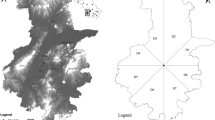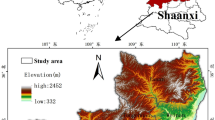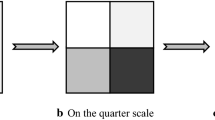Abstract
Since the industrial revolution, human activities have both expanded and intensified across the globe resulting in accelerated land use change. Land use change driven by China’s development has put pressure on the limited arable land resources, which has affected grain production. Competing land use interests are a potential threat to food security in China. Therefore, studying arable land use changes is critical for ensuring future food security and maintaining the sustainable development of arable land. Based on data from several major sources, we analyzed the spatio-temporal differences of arable land among different agricultural regions in China from 2000 to 2010 and identified the drivers of arable land expansion and loss. The results revealed that arable land decreased by 5.92 million ha or 3.31%. Arable land increased in the north and decreased in the south of China. Urbanization and ecological restoration programs were the main drivers of arable land loss, while the reclamation of other land cover types (e.g., forest, grassland, and wetland) was the primary source of the increased arable land. The majority of arable land expansion occurred in the Northwest, but the centroid for grain production moved to northeast, which indicated that new arable land was of poor quality and did not significantly contribute to the grain production capacity. When combined with the current ‘Red Line of Arable Land Policy’ (RAL) and ‘Ecological Redline Policy’ (EPR), this study can provide effective information for arable land policymaking and help guide the sustainable development of arable land.
Similar content being viewed by others
References
Bai Y, Jiang B, Wang M et al., 2016. New ecological redline policy (ERP) to secure ecosystem services in China. Land Use Policy, 55(798): 348–351. doi: 10.1016/j.landusepol.2015. 09.002
Baldos U, Hertel T W, 2015. The role of international trade in managing food security risks from climate change. Food Security, 7(2): 275–290. doi: 10.1007/s12571-015-0435-z
Berry D, 1978. Effects of urbanization on agricultural activities. Growth and Change, 9(3): 2–8. doi:10.1111/j.1468-2257. 1978.tb01024.x
Brown L R, 1995. Who Will Feed China? Wake-up Call for a Small Planet. London England Earthscan Publications.
Bruinsma J, 2009. By how much do land, water and crop yields need to increase by 2050? Expert meeting on ‘How to Feed the World in 2050’.
Cao Yingui, Yuan Chun, Zhou Wei et al., 2008. Analysis on driving forces and provincial differences of cultivated land change in China. China Land Science, 22(2): 17–22. (in Chinese)
Chen M, Liu W, Lu D, 2016. Challenges and the way forward in China’s new-type urbanization. Land Use Policy, 55(55): 334–339. doi: org/10.1016/j.landusepol.2015.07.025
Chen Yuqi, Li Xiubin, Wang Jing, 2011. Changes and effecting factors of grain production in China. Chinese Geographical Science, 21(6): 676–684. doi: 10.1007/s11769-011-0506-9
Cui X, Wang X, 2015. Urban land use change and its effect on social metabolism: an empirical study in Shanghai. Habitat International, 49: 251–259. doi: org/10.1016/j.habitatint.2015. 05.018
Delzeit R, Zabel F, Meyer C et al., 2017. Addressing future trade-offs between biodiversity and cropland expansion to improve food security. Regional Environmental Change, 17(5): 1429–1441. doi: 10.1007/s10113-016-0927-1
Deng J, Wang K, Hong Y et al., 2009. Spatio-temporal dynamics and evolution of land use change and landscape pattern in response to rapid urbanization. Landscape and urban planning, 92(3–4): 187–198. doi: org/10.1016/j.landurbplan.2009.05.001
Deng X, Huang J, Rozelle S et al., 2006. Cultivated land conversion and potential agricultural productivity in China. Land Use Policy, 23(4): 372–384. doi: org/10.1016/j.landusepol.2005.07.003
Deng X, Huang J, Rozelle S et al., 2015. Impact of urbanization on cultivated land changes in China. Land Use Policy, 45(45): 1–7. doi: org/10.1016/j.landusepol.2015.01.007
Feng Z, Yang Y, Zhang Y et al., 2005. Grain-for-green policy and its impacts on grain supply in West China. Land Use Policy, 22(4): 301–312. doi: org/10.1016/j.landusepol.2004.05.004
Grafton R Q, Daugbjerg C, Qureshi M E, 2015. Towards food security by 2050. Food Security, 7(2): 179–183. doi: 10. 1007/s12571-015-0445-x
Guan D, Li H, Inohae T et al., 2011. Modeling urban land use change by the integration of cellular automaton and Markov model. Ecological Modelling, 222(20): 3761–3772. doi: org/ 10.1016/j.ecolmodel.2011.09.009
Grau H R, Gasparri N I, Aide T M, 2008. Balancing food production and nature conservation in the Neotropical dry forests of northern Argentina. Global Change Biology, 14(5): 985–997. doi: 10.1111/j.1365-2486.2008.01554.x
He Q, Bertness M D, Bruno J et al., 2014. Pennings SC. Economic development and coastal ecosystem change in China. Scientific Reports, 4: 5995. doi: 10.1038/srep05995
Jiang P, Cheng Q, Zhuang Z et al., 2018. The dynamic mechanism of landscape structure change of arable landscape system in China. Agriculture, Ecosystems & Environment, 251: 26–36. doi: org/10.1016/j.agee.2017.09.006
Kastner T, Rivas M J I, Koch W et al., 2012. Global changes in diets and the consequences for land requirements for food. Proceedings of the National Academy of Sciences, 109(18): 6868–6872. doi: 10.1073/pnas.1117054109
Kompas T, Nguyen H T M, Van Ha P, 2015. Food and biosecu-rity: livestock production and towards a world free of foot-and-mouth disease. Food Security, 7(2): 291–302. doi: 10.1007/s12571-015-0436-y
Kuang W, Liu J, Dong J et al., 2016. The rapid and massive urban and industrial land expansions in China between 1990 and 2010: a clud-based analysis of their trajectories, patterns, and drivers. Landscape and Urban Planning, 145(145): 21–33. doi: org/10.1016/j.landurbplan.2015.10.001
Lam H, Remais J, Fung M et al., 2013. Food supply and food safety issues in China. Lancet, 381(9882): 2044–2053. doi: org/10.1016/S0140-6736(13)60776-X
Larson C, 2013. Losing arable land, China faces stark choice: adapt or go hungry. Science, 339(6120): 644–645. doi: 10. 1126/science.339.6120.644
Lei D, Shangguan Z, Rui L, 2012. Effects of the grain-for-green program on soil erosion in China. International Journal of Sediment Research, 27(1): 120–127. doi: org/10.1016/S1001-6279(12)60021-3
Lichtenberg E, Ding C, 2008. Assessing farmland protection policy in China. Land Use Policy, 25(1): 59–68. doi: org/10.1016/ j.landusepol.2006.01.005
Li J, Feldman M W, Li S et al., 2011. Rural household income and inequality under the Sloping Land Conversion Program in western China. Proceedings of the National Academy of Sciences, 108(19): 7721–7726. doi: 10.1073/pnas.1101018108
Li W, Feng T, Hao J, 2009. The evolving concepts of land administration in China: Cultivated land protection perspective. Land Use Policy, 26(2): 262–272. doi: org/10.1016/j. landusepol.2008.02.008
Liu J, 2014. Forest sustainability in China and implications for a telecoupled world. Asia & the Pacific Policy Studies, 1(1): 230–250. doi: 10.1002/app5.17
Liu J, Hull V, Yang W et al., 2016. Pandas and People: Coupling Human and Natural Systems for Sustainability. United States of America: Oxford University Press.
Liu X, Wang J, Liu M et al., 2005. Spatial heterogeneity of the driving forces of cropland change in China. Science in China Series D: Earth Sciences, 48(12): 2231–2240. doi: 10.1360/ 04yd0195
Liu Y, Fang F, Li Y, 2014. Key issues of land use in China and implications for policy making. Land Use Policy, 40(40): 6–12. doi: org/10.1016/j.landusepol.2013.03.013
Long H, Li Y, Liu Y et al., 2012. Accelerated restructuring in rural China fueled by ‘increasing vs. decreasing balance’ land-use policy for dealing with hollowed villages. Land Use Policy, 29(1): 11–22. doi: org/10.1016/j.landusepol.2011.04.003
Lu Z, Deng X, 2011. China’s western development strategy: policies, effects and prospects. Available at: https://mpra.ub.uni-muenchen.de/35201/
Ma Z, Melville D S, Liu J et al., 2014. Rethinking China’s new great wall. Science, 346(6212): 912–914. doi:10.1126/science. 1257258
Nath R, Luan Y, Yang W et al., 2015. Changes in arable land demand for food in India and China: a potential threat to food security. Sustainability, 7(5): 5371–5397. doi:10.3390/su 7055371
Ouyang Z, Zheng H, Xiao Y et al., 2016. Improvements in ecosystem services from investments in natural capital. Science, 352(6292): 1455–1459. doi: 10.1126/science.aaf2295
Peng J, Liu Y, Li T et al., 2017a. Regional ecosystem health response to rural land use change: a case study in Lijiang City, China. Ecological Indicators, 72: 399–410. doi: org/10.1016/ j.ecolind.2016.08.024
Peng J, Zhao M, Guo X et al., 2017b. Spatial-temporal dynamics and associated driving forces of urban ecological land: a case study in Shenzhen city, China. Habitat International, 60: 81–90. doi: org/10.1016/j.habitatint.2016.12.005
Rao E, Ouyang Z, Yu X et al., 2014. Spatial patterns and impacts of soil conservation service in China. Geomorphology, 207(1): 64–70. doi: org/10.1016/j.geomorph.2013.10.027
Rao Enming, Xiao Yi, Ouyang Zhiyun et al., 2016. Changes in ecosystem service of soil conservation between 2000 and 2010 and its driving factors in southwestern China. Chinese Geographical Science, 26: 165–173. doi: 10.1007/s11769-015-0759-9
Roberts L, 2011. 9 Billion? Science, 333(6042): 50–543. doi: 10.1126/science.333.6042.540
Sun J, Tong Y, Liu J, 2017. Telecoupled land-use changes in distant countries. Journal of Integrative Agriculture, 16(2): 368–376. doi: org/10.1016/S2095-3119(16)61528-9
Sun J, Wu W, Tang H et al., 2015. Spatiotemporal patterns of non–genetically modified crops in the era of expansion of genetically modified food. Scientific Reports, 5:14180. doi: 10.1038/srep14180
Tan M, Li X, Xie H et al., 2005. Urban land expansion and arable land loss in China: a case study of Beijing-Tianjin-Hebei region. Land Use Policy, 22(3): 187–196. doi: org/10.1016/j. landusepol.2004.03.003
Tian G, Qiao Z, 2014. Assessing the impact of the urbanization process on net primary productivity in China in 1989–2000. Environmental Pollution, 184: 320–326. doi: org/10.1016/j. envpol.2013.09.012
Tilman D, Balzer C, Hill J et al., 2011. Global food demand and the sustainable intensification of agriculture. Proceedings of the National Academy of Sciences, 108(50): 20260–20264. doi: 10.1073/pnas.1116437108
Tuanmu M N, Vina A, Yang W et al., 2016. Effects of payments for ecosystem services on wildlife habitat recovery. Conservation Biology, 30(4): 827–835. doi: 10.1111/cobi.12669
United Nations. 2013. ‘World Population Prospects: The 2012 Revision, Volume II: Demographic Profiles, United Nations Department of Economic and Social Affairs, Population Division’. World Population Prospects: The 2012 Revision.
Viña A, McConnell W J, Yang H et al., 2016. Effects of conservation policy on China’s forest recovery. Science Advances, 2(3): e1500965. doi: 10.1126/sciadv.1500965
Wang J, Peng J, Zha M et al., 2017. Significant trade-off for the impact of Grain-for-Green Programme on ecosystem services in North-western Yunnan, China. Science of the To t a l Environment, 574: 57–64. doi:org/10.1016/j.scitotenv.2016.09.026
Wang Liyan, Xiao Yi, Rao Enming et al., 2015. Spatial characteristics of food provision service and its impact factors in China. Journal of Natural Resources, 30(2):189–193. (in Chinese)
Wang Wengang, Pang Xiaoxiao, Song Yuxiang et al., 2012. The spatial different features of construction land changes in China. Areal Research and Development, 31(1): 110–115. (in Chinese)
Wen Jiabao, 2011. Report on the Work of the Government. Proceedings of the Delivered at the Fourth Session of the Eleventh National People’s Congress, Beijing, 5th March. (in Chinese)
Xu Z, Xu J, Deng X et al., 2006. Grain for Green and Grain: a case study of the conflict between food security and the environment in China. World Development, 34(1): 130–148
Yang Bangjie, Gao Jixi, Zou Changxin, 2014. The strategic significance of drawing the ecological protection red line. China Development, 14:1–4. (in Chinese).
Yang, H, Li X, 2000. Cultivated land and food supply in China. Land Use Policy, 17(2): 73–88. doi: org/10.1016/S0264-8377 (00)00008-9
Zhang C, Robinson D, Wang J et al., 2011. Factors influencing farmers’ willingness to participate in the conversion of cultivated land to wetland program in Sanjiang National Nature Reserve, China. Environmental management, 47(1): 107–120. doi: 10.1007/s00267-010-9586-z
Zhou H, Van R A, 2009. Detecting the impact of the ‘Grain for Green’ program on the mean annual vegetation cover in the Shaanxi Province, China using SPOT-VGT NDVI data. Land Use Policy, 26(4): 954–960. doi: org/10.1016/j.landusepol. 2008.11.006
Zhou Lisan, Sun Han, Shen Yuqing, 1981. China’s comprehensive agricultural regionalization. Beijing: Agricultural Publishing House, 7: 2–9. (in Chinese)
Acknowledgments
The authors acknowledge the Institute of Remote Sensing Applications, Chinese Academy of Sciences (CAS) that kindly provided the mapped data to definite the distribution of arable land.
Author information
Authors and Affiliations
Corresponding author
Additional information
Foundation item: under the auspices of Chinese Academy of Science Services Network Program (No. KFJ-STS-ZDTP-010), Michigan AgBio Research Program
Rights and permissions
About this article
Cite this article
Wang, L., Anna, H., Zhang, L. et al. Spatial and Temporal Changes of Arable Land Driven by Urbanization and Ecological Restoration in China. Chin. Geogr. Sci. 29, 809–819 (2019). https://doi.org/10.1007/s11769-018-0983-1
Received:
Accepted:
Published:
Issue Date:
DOI: https://doi.org/10.1007/s11769-018-0983-1




